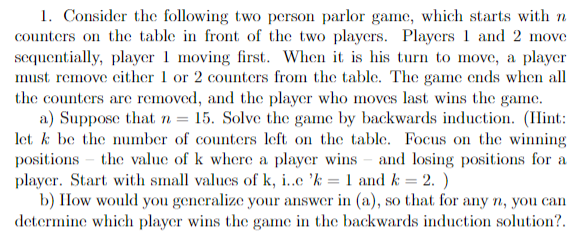1. Consider the following two person parlor game, which starts with n counters on the table in front of the two players. Players 1 and 2 move sequentially, player 1 moving first. When it is his turn to move, a player must remove either 1 or 2 counters from the table. The game ends when all the counters are removed, and the player who moves last wins the game. a) Suppose that n = 15. Solve the game by backwards induction. (Hint: let k be the number of counters left on the table. Focus on the winning positions the value of k where a player wins and losing positions for a player. Start with small values of k, i..c 'k = 1 and k = 2.) b) How would you generalize your answer in (a), so that for any n, you can determine which player wins the game in the backwards induction solution?.
1. Consider the following two person parlor game, which starts with n counters on the table in front of the two players. Players 1 and 2 move sequentially, player 1 moving first. When it is his turn to move, a player must remove either 1 or 2 counters from the table. The game ends when all the counters are removed, and the player who moves last wins the game. a) Suppose that n = 15. Solve the game by backwards induction. (Hint: let k be the number of counters left on the table. Focus on the winning positions the value of k where a player wins and losing positions for a player. Start with small values of k, i..c 'k = 1 and k = 2.) b) How would you generalize your answer in (a), so that for any n, you can determine which player wins the game in the backwards induction solution?.
Chapter8: Sequences, Series,and Probability
Section8.6: Counting Principles
Problem 74E: Lottery Powerball is a lottery game that is operated by the Multi-State Lottery Association and is...
Related questions
Question
100%

Transcribed Image Text:1. Consider the following two person parlor game, which starts with n
counters on the table in front of the two players. Players 1 and 2 move
sequentially, player 1 moving first. When it is his turn to move, a player
must remove either 1 or 2 counters from the table. The game ends when all
the counters are removed, and the player who moves last wins the game.
a) Suppose that n = 15. Solve the game by backwards induction. (Hint:
let k be the number of counters left on the table. Focus on the winning
positions the value of k where a player wins and losing positions for a
player. Start with small values of k, i..c 'k = 1 and k = 2.)
b) How would you generalize your answer in (a), so that for any n, you can
determine which player wins the game in the backwards induction solution?.
Expert Solution
This question has been solved!
Explore an expertly crafted, step-by-step solution for a thorough understanding of key concepts.
This is a popular solution!
Trending now
This is a popular solution!
Step by step
Solved in 2 steps with 1 images

Recommended textbooks for you

